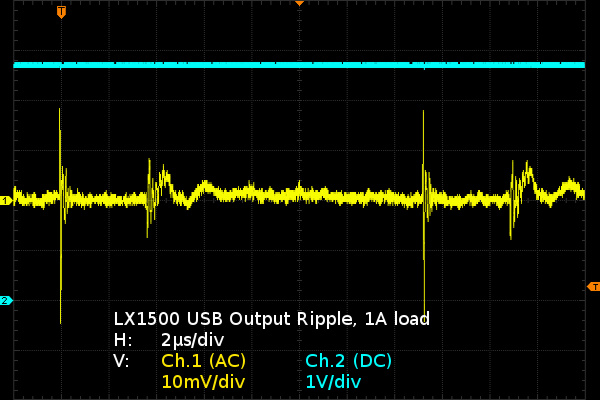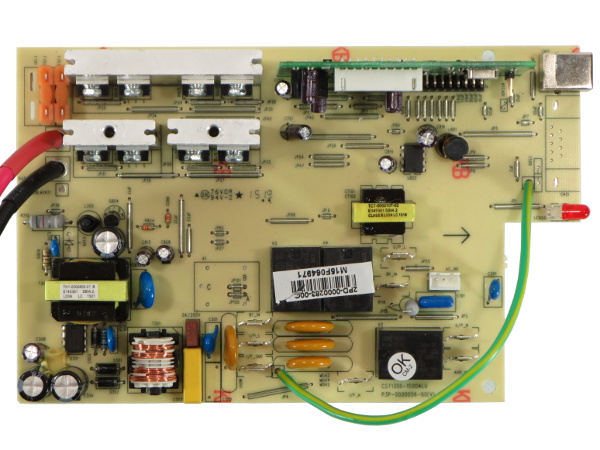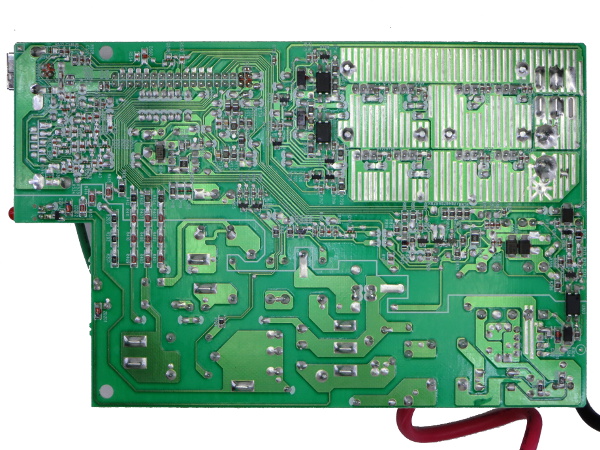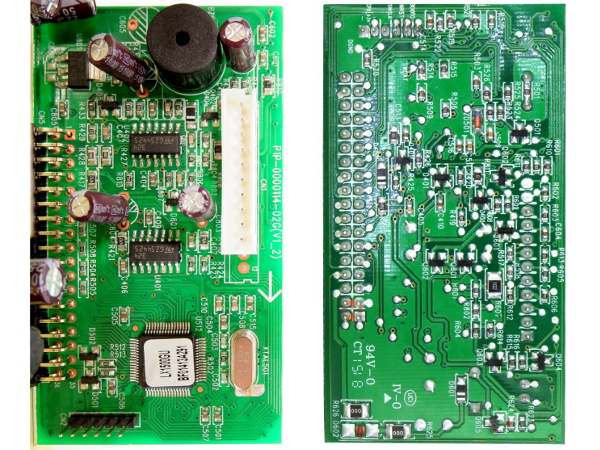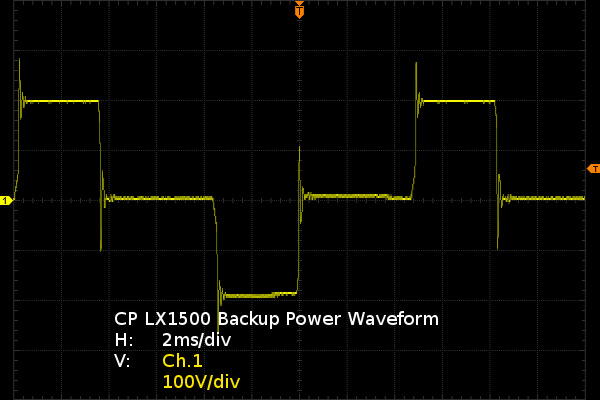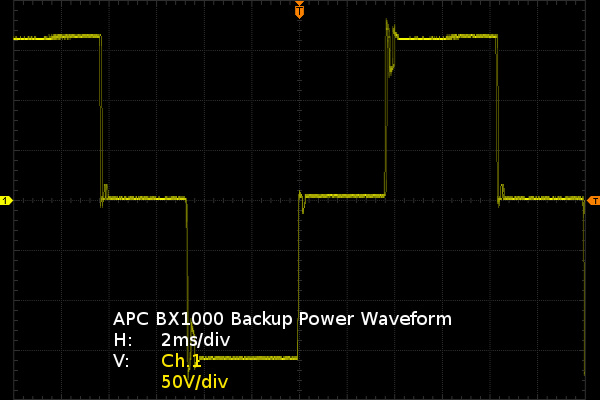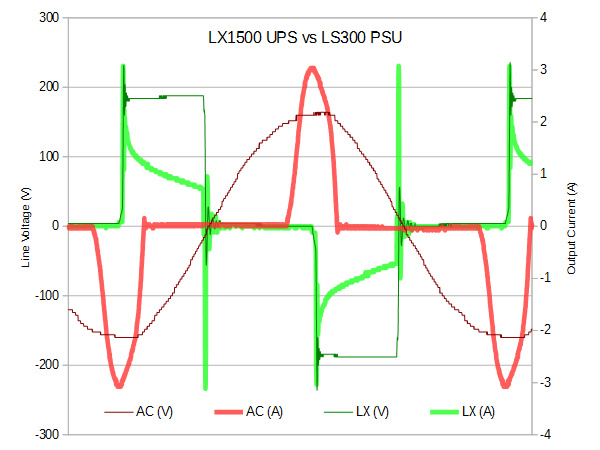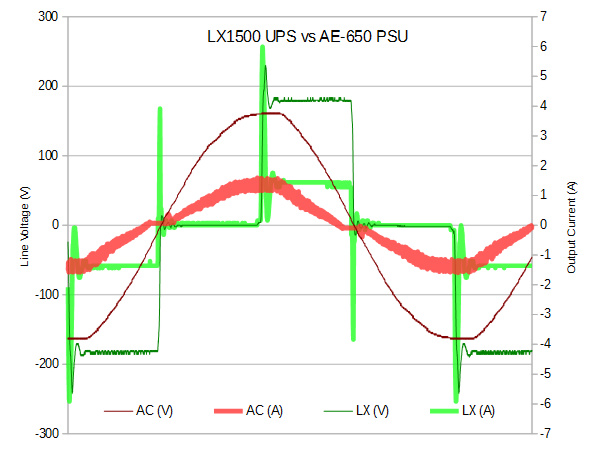CyberPower LX1500GU-FC UPS Tear-Down
USB Power Supply Output
Under open circuit condition, the supply outputs 5.12V with 60mVPP of ringing and 100mVPP of switching transient noise. At 1A output current, I got exactly 5V at the USB plug and the pictured waveforms across my load. Switching transients died down as soon as there was any load on the output, which is good. We can clearly see the 50-70mVPP turn-on transients at the oscilloscope's trigger point, followed by more small transients and a slight ringing with less than 10mV initial magnitude at turn-off.
Having that 10µF capacitor I mentioned on the USB connector board would have eliminated most transients from the USB output. A common-mode choke does you no good when there is no load attached to close the loop.
For Comparison's Sake
Here is the output from my 2012 Nexus 7's original AC adapter. The thing is over three years old, has been plugged in nearly 24/7 all along, yet still produces output with negligible ripple, negligible ringing and 30mVPP transients under 1A load.
Genuine OEM adapters usually carry high premium prices as replacement parts or accessories. But some of them are legitimately over-engineered. The LX1500's USB output is almost that good, at least for now.
The Main Board
There are four distinct areas on the circuit board: the low-power, low-voltage control area with the daughterboard and output current-sensing transformer in the top-right corner; the line voltage section with AVR/bypass relays and four 14mm MOVs in the bottom-right corner; the UPS' internal power supply, which also provides charging in the bottom-left corner; and the inverter bridge in the top-left to drive the transformer. All electrolytic capacitors come from Su'scon and include the low-voltage HG series, UX for the battery charger output and SE for the mains input.
The only EMI filtering provided by this UPS is what it needs to suppress noise from its own power supply.
Main PCB Bottom
Soldering quality looks good across the board. Aside from a bucket of resistors, capacitors, some diodes and transistors, its residents also include three 817-style photocouplers. One of those couplers is used for the charger's feedback loop and the two others drive the inverter's MOSFETs.
Get Tom's Hardware's best news and in-depth reviews, straight to your inbox.
Driving 1500VA out of the transformer requires pushing nearly 70A. If you have no idea what this translates to in terms of circuit board layout, here is a hint: it is not subtle.
Some Delegation Required
The analog and digital magic required to bring the LX1500 to life requires higher circuit density than what can be accommodated on a single-sided board. Instead of making the main board double-sided and finding space for these components, CyberPower put them on a riser card.
What is on there? A microcontroller, a pair of 324 quad op-amps, a buzzer and a linear regulator on the front. The back side is covered in the usual complement of resistors, capacitors, diodes and transistors.
Standby Power
How much power does an EnergyStar UPS draw while doing nothing? The LX1500 had a few hours to top off its batteries and the initial 40W died down to 8.8W. To meet EnergyStar UPS requirements, a UPS must have 96.7 percent weighed average efficiency across 25, 50, 75 and 100 percent load test points weighed 0.2, 0.2, 0.3 and 0.3, respectively. With 8.8W of internal power draw and 5W of weighed wiring losses, the LX1500 should achieve an overall efficiency of 98.5 percent.
Output Waveform
If you were wondering what a "modified sine wave" with 46 percent of THD and 34 percent peak harmonic looked like, this is what the LX1500 produces. Its output goes to 190V with 40 percent duty cycle, which yields 125VRMS with a slight amount of ringing at each transition. During battery operation, a slight buzzing can be heard from the transformer.
Why do some power supplies with APFC have trouble with this waveform? It is usually because their APFC controller shuts down or misbehaves when it detects a non-sinusoidal input. When the main converter is designed to expect APFC-boosted input voltage, losing the input boost may be sufficient to make it shut down. At 190V, though, most converters should have little trouble operating without it.
More Comparisons
The BX1000's electronic inverter produces perfectly flat plateaus at 160V with a 57 percent duty cycle resulting in 121V RMS. Here, what may look like ringing is actually a choke getting switched in and out to soften the slopes. In operation, the BX1000 generates a distinctly audible 120Hz buzz.
Two completely different implementations of the same general waveform, nearly identical results. But it's still looking good for a 10-year-old device. I just need to investigate why it's excessively sensitive to noise.
Non-PFC Current Waveform
Many people are wary of connecting electronic equipment to a modified sine wave UPS out of fear that the fast edges might damage input rectifiers or capacitors. I decided to have a look.
Here, I am using the SL300 supply I repaired a few months ago to power a 15-foot 12V 80W LED strip. While intuition may spontaneously dictate that the "square wave" plotted in dark green should have worse peak current than smooth AC plotted in dark red, practice shows that flat tops keep capacitors charged longer than AC peaks do. With capacitors having less time to discharge between pulses, peaks remain of similar magnitude but much shorter duration.
Try to avoid connecting large iron core transformers (“linear adapters”) and AC motors to UPS though: the harmonics will greatly increase core losses.
APFC Current Waveform
Some people also believe that an APFC power supply requires a "pure sine wave" UPS. For this round, I used my PC as the load since its EA-650 is the only APFC supply I currently own. As a bonus, it is one of the pre-Green Delta-made EarthWatts models that allegedly had issues with modified sine wave UPS.
As expected under AC, the current follows line voltage, albeit a little noisily. Under battery power, though, the EA's APFC circuit does not skip a beat. The momentary peak at over 5A is caused by APFC trying to follow the rising edge. Once it figures out that the slope is too steep for a sine wave, it switches to boost regulator mode for the remainder of the pulse.
-
Nuckles_56 This was really interesting thanks Daniel, I was surprised how many corners they cut when building this and I guess if I decide to buy a UPS, I'll have to do some serious research to ensure that the one I buy isn't like thisReply -
Daniel Sauvageau Reply
If you buy an UPS for the UPS function only, you can ignore the gimmick extras and that makes it ok-ish in my book. To get 9AH batteries from APC or Tripp-Lite, you need to spend 20-30% more,17616866 said:I was surprised how many corners they cut when building this -
Onus I would love to see a teardown of one of Cyberpower's APFC units. My Delta-built SG-650 WILL NOT run on a cheap UPS, but runs fine on a Cyberpower 1500PFCLCD (and on a smaller one as well). I'm curious as to how close to true-sine it really is; I believe it is a clipped-triangle, but I don't have an oscilloscope myself to check it.Reply
What I saw in this review was not a "modified sine wave;" it looked a lot like a square wave with some funk at the corners.
-
gamebrigada I'm raging about cyberpower right now. Started buying their stuff about 2 and a half years ago because of good pricing. I have probably a dozen UPS's from them, 3 have failed in the past 3 months. Not looking good for the brand so far. Especially when I've never had an APC ups fail for any reason other than its batteries, with 10 year old models still holding their own.Reply -
Epsilon_0EVP Not being extremely knowledgeable in electrical circuitry, I find it extremely alarming that every teardown of a surge protector or battery backup I have seen on this site points out glaring manufacturing issues, cut corners, and overall shoddy design and workmanship. It makes me question how much safer my electronics actually are when connected to these devices, given that I seem to be eliminating one possible point of failure by introducing another one. Could anyone more knowledgeable provide some thoughts on this?Reply -
ammaross I disregard the ethernet and coax passthrus (for obvious, and now shown, reasons). However, I'd love to see a teardown of the Pure Sine wave units from CyberPower and APC (APC is my pref brand, but not usually a cheap to aquire, whereas CP is usually on a great sale somewhat often).Reply -
Daniel Sauvageau Reply
Most of them, sure. All of them? No. The SurgeArrest Performance, both the old model from 10+ years ago and the newer model currently on the market are quite decent for $30-40 US. For $10-20 more, the Tripp-Lite isobar knocks build quality up a few notches with proper power outlets, extruded aluminum body and beefier filter inductors. (Although the "isolated outlet banks" turned out to be questionable.) The SurgeX unit kicked that up a few more notches, although its $400 price tag is a "little" steep.17618830 said:Not being extremely knowledgeable in electrical circuitry, I find it extremely alarming that every teardown of a surge protector or battery backup I have seen on this site points out glaring manufacturing issues, cut corners, and overall shoddy design and workmanship.
Right now, I'm trying to keep an eye on sales. While I was putting the LX1500 story together, I missed a sale on the PFC variant for only $10 extra. I didn't want to buy $400+ worth of UPS before knowing whether interest would be there. -
Daniel Sauvageau Reply
They call it "modified sine" because the bipolar return-to-zero waveform has lower total harmonic content than a plain square wave. It may not look sinusoidal but as far as the Fourrier transform is concerned, it should be close enough for most purposes.17618266 said:What I saw in this review was not a "modified sine wave;" it looked a lot like a square wave with some funk at the corners.
As for the "funk at the corners", that's likely the transformer's inductance resonating with the PSU's EMI filter capacitors. There isn't much of it on the APC since the old BX1000 drives HVDC to its output through an H-bridge, not much bulk inductance for load caps to resonate with there.
